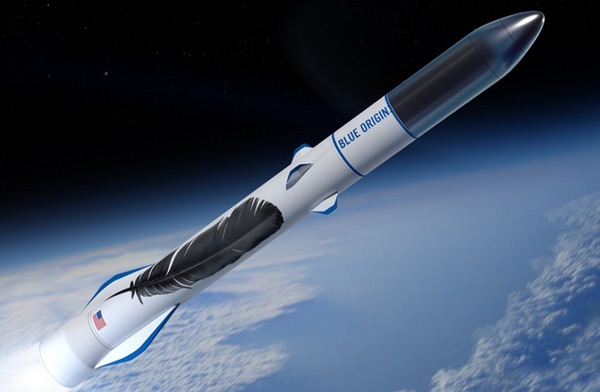Blue Origin and Virgin Orbit on the launch rangeby Antoine Meunier
|
| If the philosophy of the company founded by Jeff Bezos is to have “millions of people living and working in space,” Mowry seems to be more pragmatic and probably more realistic. |
At the same time, two new launchers will theoretically enter into service. The first one is the New Glenn from Blue Origin, whose first visual was unveiled during the 2016 edition of the conference. The two versions of the launcher (two and three stages each for a respective height of 86 and 99 meters) have a fairing of seven meters in diameter. Using seven BE-4 engines powered by liquid oxygen and methane, the first stage of New Glenn must be able to be reused a hundred times (which was also envisaged with the Space Shuttle in the past) “with minimal maintenance between two flights”, said Clay Mowry of Blue Origin. The second stage of the New Glenn vehicle also uses the BE-4 engine for propulsion and can be re-ignitable. The third stage works with a BE-3 engine (liquid oxygen-liquid hydrogen) like on the New Shepard booster.
Logic of steps
From a recovery perspective, Mowry recalls Blue Origin’s policy of “Gradatim Ferociter”, which means “furiously step by step,” including the New Shepard suborbital launcher. It was successively flown five times between November 2015 and October 2016. “This vehicle allowed us to learn how to re-use,” he said. New Glenn offers a payload capacity of 45 tons to LEO and up to 13 tons to GTO.
If the philosophy of the company founded by Jeff Bezos is to have “millions of people living and working in space,” Mowry seems to be more pragmatic and probably more realistic. He declared that “our first objective remains the commercial market in the market for LEO and GTO satellites”. In 2021 or 2022, Eutelsat will be the first commercial client to use the New Glenn rocket to launch an unmanned vehicle.
A different first stage
However, if part of the Blue Origin business includes human space flights, Virgin Orbit does not. The 200 employees of this young division of the Virgin group (established in March) aim to launch small satellites weighing up to 300 kilograms into sun-synchronous orbit (SSO) and up to 500 kilograms in other orbits. The approach is a little different since “our first stage is totally reusable,” says Dan Hart, the CEO of Virgin Orbit. The “first stage” in question is none other than an old Boeing 747 from Virgin Atlantic, known as “Cosmic Girl,” which will be used as the air launch stage of LauncherOne. When the plane arrives at an altitude of more than 10,000 meters, LauncherOne will detach from Cosmic Girl and ignited for three minutes its Newton Three engine of its first stage, which uses a liquid oxygen-kerosene mixture. A six-minute burn by the second stage places the satellite into orbit.
The initial LauncherOne flight is planned for next year. Nevertheless, from 2019, the company expects that it will be able to carry out up to 12 successive launches and up to 24 in 2020. In 2021, this access should be regular. It is also a matter of Virgin Orbit achieving a degree of reliability similar to that of airlines. One of the first customers of Virgin Orbit is the American company Cloud Constellation Corporation for the deployment of its SpaceBelt constellation. On the sidelines of the conference, the two companies signed a contract for the launch of the first twelve satellites, which will form the core of the device. The initial launch of LauncherOne under this deal is scheduled for early 2019.
